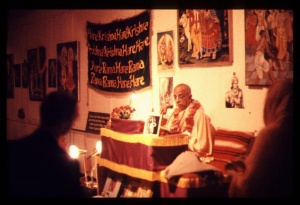CC Madhya 20.339: Difference between revisions
m (1 revision(s)) |
(Vanibot #0054 edit - transform synonyms into clickable links, which search similar occurrences) |
||
| (One intermediate revision by one other user not shown) | |||
| Line 1: | Line 1: | ||
{{ | [[Category:Sri Caitanya-caritamrta - Madhya-lila Chapter 20|C339]] | ||
<div style="float:left">'''[[Sri Caitanya-caritamrta|Śrī Caitanya-caritāmṛta]] - [[CC Madhya|Madhya-līlā]] - [[CC Madhya 20|Chapter 20: Lord Śrī Caitanya Mahāprabhu Instructs Sanātana Gosvāmī in the Science of the Absolute Truth]]'''</div> | |||
<div style="float:right">[[File:Go-previous.png|link=CC Madhya 20.338|Madhya-līlā 20.338]] '''[[CC Madhya 20.338|Madhya-līlā 20.338]] - [[CC Madhya 20.340|Madhya-līlā 20.340]]''' [[File:Go-next.png|link=CC Madhya 20.340|Madhya-līlā 20.340]]</div> | |||
{{CompareVersions|CC|Madhya 20.339|CC 1975|CC 1996}} | |||
{{RandomImage}} | |||
==== TEXT 339 ==== | ==== TEXT 339 ==== | ||
<div | <div class="verse"> | ||
ei mantre dvāpare kare kṛṣṇārcana | :ei mantre dvāpare kare kṛṣṇārcana | ||
‘kṛṣṇa-nāma-saṅkīrtana’—kali-yugera dharma | :‘kṛṣṇa-nāma-saṅkīrtana’—kali-yugera dharma | ||
</div> | </div> | ||
| Line 12: | Line 16: | ||
==== SYNONYMS ==== | ==== SYNONYMS ==== | ||
<div | <div class="synonyms"> | ||
ei | ''[//vanipedia.org/wiki/Special:VaniSearch?s=ei&tab=syno_o&ds=1 ei] [//vanipedia.org/wiki/Special:VaniSearch?s=mantre&tab=syno_o&ds=1 mantre]'' — by this ''mantra''; ''[//vanipedia.org/wiki/Special:VaniSearch?s=dvāpare&tab=syno_o&ds=1 dvāpare]'' — in the Age of Dvāpara; ''[//vanipedia.org/wiki/Special:VaniSearch?s=kare&tab=syno_o&ds=1 kare]'' — perform; ''[//vanipedia.org/wiki/Special:VaniSearch?s=kṛṣṇa&tab=syno_o&ds=1 kṛṣṇa]-[//vanipedia.org/wiki/Special:VaniSearch?s=arcana&tab=syno_o&ds=1 arcana]'' — the worship of Lord Kṛṣṇa; ''[//vanipedia.org/wiki/Special:VaniSearch?s=kṛṣṇa&tab=syno_o&ds=1 kṛṣṇa]-[//vanipedia.org/wiki/Special:VaniSearch?s=nāma&tab=syno_o&ds=1 nāma]-[//vanipedia.org/wiki/Special:VaniSearch?s=saṅkīrtana&tab=syno_o&ds=1 saṅkīrtana]'' — chanting of the holy name of Lord Kṛṣṇa; ''[//vanipedia.org/wiki/Special:VaniSearch?s=kali&tab=syno_o&ds=1 kali]-[//vanipedia.org/wiki/Special:VaniSearch?s=yugera&tab=syno_o&ds=1 yugera] [//vanipedia.org/wiki/Special:VaniSearch?s=dharma&tab=syno_o&ds=1 dharma]'' — the occupational duty in the Age of Kali. | ||
</div> | </div> | ||
| Line 19: | Line 23: | ||
==== TRANSLATION ==== | ==== TRANSLATION ==== | ||
<div | <div class="translation"> | ||
“By this mantra, the people worship Lord Kṛṣṇa in Dvāpara-yuga. In Kali-yuga the occupational duty of the people is to chant congregationally the holy name of Kṛṣṇa. | “By this mantra, the people worship Lord Kṛṣṇa in Dvāpara-yuga. In Kali-yuga the occupational duty of the people is to chant congregationally the holy name of Kṛṣṇa. | ||
</div> | </div> | ||
| Line 26: | Line 30: | ||
==== PURPORT ==== | ==== PURPORT ==== | ||
<div | <div class="purport"> | ||
As stated in Śrīmad-Bhāgavatam ([[SB 12.3.51]]): | As stated in [[Srimad-Bhagavatam|''Śrīmad-Bhāgavatam'']] ([[SB 12.3.51]]): | ||
:kaler doṣa-nidhe rājann asti hy eko mahān guṇaḥ | :''kaler doṣa-nidhe rājann asti hy eko mahān guṇaḥ'' | ||
:kīrtanād eva kṛṣṇasya mukta-bandhaḥ paraṁ vrajet | :''kīrtanād eva kṛṣṇasya mukta-bandhaḥ paraṁ vrajet'' | ||
“My dear King, although Kali-yuga is full of faults, there is still one good quality about this age. It is that simply by chanting the Hare Kṛṣṇa mahā-mantra, one can become free from material bondage and be promoted to the transcendental kingdom.” Thus in Kali-yuga one worships Lord Kṛṣṇa by chanting Hare Kṛṣṇa, Hare Kṛṣṇa, Kṛṣṇa Kṛṣṇa, Hare Hare/ Hare Rāma, Hare Rāma, Rāma Rāma, Hare Hare. To propagate this movement, Lord Kṛṣṇa personally appeared as Lord Caitanya Mahāprabhu. That is described in the following verse. | “My dear King, although Kali-yuga is full of faults, there is still one good quality about this age. It is that simply by chanting the Hare Kṛṣṇa ''mahā-mantra'', one can become free from material bondage and be promoted to the transcendental kingdom.” Thus in Kali-yuga one worships Lord Kṛṣṇa by chanting Hare Kṛṣṇa, Hare Kṛṣṇa, Kṛṣṇa Kṛṣṇa, Hare Hare/ Hare Rāma, Hare Rāma, Rāma Rāma, Hare Hare. To propagate this movement, Lord Kṛṣṇa personally appeared as Lord Caitanya Mahāprabhu. That is described in the following verse. | ||
</div> | </div> | ||
__NOTOC__ | |||
<div style="float:right; clear:both;">[[File:Go-previous.png|link=CC Madhya 20.338|Madhya-līlā 20.338]] '''[[CC Madhya 20.338|Madhya-līlā 20.338]] - [[CC Madhya 20.340|Madhya-līlā 20.340]]''' [[File:Go-next.png|link=CC Madhya 20.340|Madhya-līlā 20.340]]</div> | |||
__NOTOC__ | |||
__NOEDITSECTION__ | |||
Latest revision as of 22:43, 19 February 2024

A.C. Bhaktivedanta Swami Prabhupada
TEXT 339
- ei mantre dvāpare kare kṛṣṇārcana
- ‘kṛṣṇa-nāma-saṅkīrtana’—kali-yugera dharma
SYNONYMS
ei mantre — by this mantra; dvāpare — in the Age of Dvāpara; kare — perform; kṛṣṇa-arcana — the worship of Lord Kṛṣṇa; kṛṣṇa-nāma-saṅkīrtana — chanting of the holy name of Lord Kṛṣṇa; kali-yugera dharma — the occupational duty in the Age of Kali.
TRANSLATION
“By this mantra, the people worship Lord Kṛṣṇa in Dvāpara-yuga. In Kali-yuga the occupational duty of the people is to chant congregationally the holy name of Kṛṣṇa.
PURPORT
As stated in Śrīmad-Bhāgavatam (SB 12.3.51):
- kaler doṣa-nidhe rājann asti hy eko mahān guṇaḥ
- kīrtanād eva kṛṣṇasya mukta-bandhaḥ paraṁ vrajet
“My dear King, although Kali-yuga is full of faults, there is still one good quality about this age. It is that simply by chanting the Hare Kṛṣṇa mahā-mantra, one can become free from material bondage and be promoted to the transcendental kingdom.” Thus in Kali-yuga one worships Lord Kṛṣṇa by chanting Hare Kṛṣṇa, Hare Kṛṣṇa, Kṛṣṇa Kṛṣṇa, Hare Hare/ Hare Rāma, Hare Rāma, Rāma Rāma, Hare Hare. To propagate this movement, Lord Kṛṣṇa personally appeared as Lord Caitanya Mahāprabhu. That is described in the following verse.